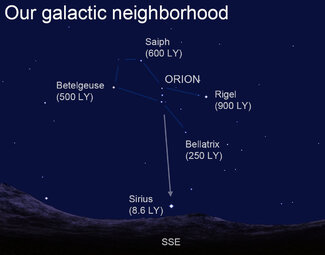Orion Distances
Last updated 2/15/2024 at 12:22pm

Though we imagine some of these stars as one thing (Orion), they are actually very different distances from us.
With the moon appearing so bright this week, it'll be hard to see much in the night sky except for the moon itself along with the brilliant planet Jupiter high overhead.
Fortunately, at this time of year, our sky is adorned with some of the brightest stars of the entire year: the region of Orion, the hunter. This is beginning to rise above the eastern horizon after sunset, and you should be able to see these stars easily even over bright moonlight.
Orion marks a fascinating piece of celestial real estate, and his mythology is quite ancient. He was known to the Sumerians of Mesopotamia; the Egyptians saw him as the god Osiris; and some early Greek stories portray him as a great and strong hunter and son of the sea god Poseidon.
It's understandable why they chose a great hunter to represent this star grouping: It's one of the few constellations that – with some imagination – can be made to resemble its namesake.
Two stars – Betelgeuse and Bellatrix – mark the shoulders of the celestial giant. Saiph and Rigel form his knees. And his midsection sports three stars in a nearly straight line that outline his belt. Unfortunately, the fainter stars that make up his head and arms won't be visible until we lose the bright moonlight next week.
We can, however, follow the three "belt" stars downward toward the east and find Sirius, the brightest star in the heavens and the main star of Canis Major, the great hunting dog.
With only these brilliant stars visible in the moonlight this week, let's take the opportunity to ponder an interesting thought: What would Orion look like if we could travel there to see it up close?
The question is one I've received many times over the years, but it presupposes that Orion is a real place. It is not. What we trace out as shapes in the sky are simply our imaginations attempting to make some sense out of a celestial maze of randomly scattered stars.
In fact, all stars are at greatly different distances from us. Take Sirius, for example. Not only is it the brightest star in the heavens, but it's one of the nearest as well, lying only about 8.6 light-years away.
A light-year, if you recall, is the distance that a beam of light can travel in one year – about six trillion miles. So, Sirius lies about 51 trillion miles away. That's 51 followed by 12 zeroes.
The stars of Orion are considerably farther. Bellatrix is the closest of those we can see this week, lying some 250 light-years away (about 1,500 trillion miles). Using light-years, however, gives us another perspective. Since the light of Bellatrix has taken 250 years to reach us, we see that star as it was in 1773!
Other stars are considerably farther. For example, the reddish-orange supergiant star Betelgeuse is about 500 light-years from us. It's a star that's on the verge of going supernova, but when it does, half a millennium will pass before the light reaches us!
Yes, indeed, even under brilliant moonlight, the night sky can sure alter our perspective!
Visit Dennis Mammana at dennismammana.com.



